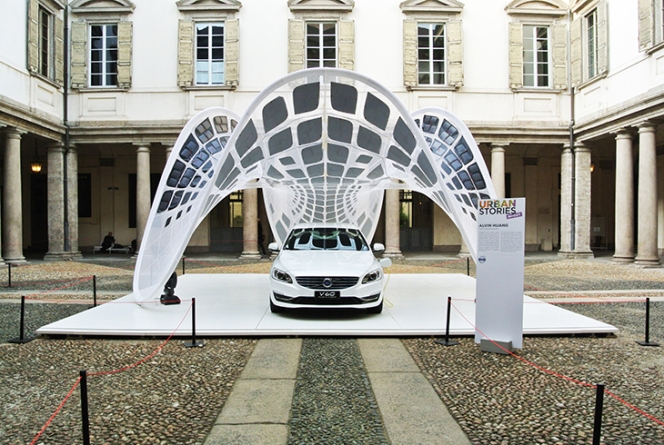Your Cart is Empty
Customer Testimonials
-
"Great customer service. The folks at Novedge were super helpful in navigating a somewhat complicated order including software upgrades and serial numbers in various stages of inactivity. They were friendly and helpful throughout the process.."
Ruben Ruckmark
"Quick & very helpful. We have been using Novedge for years and are very happy with their quick service when we need to make a purchase and excellent support resolving any issues."
Will Woodson
"Scott is the best. He reminds me about subscriptions dates, guides me in the correct direction for updates. He always responds promptly to me. He is literally the reason I continue to work with Novedge and will do so in the future."
Edward Mchugh
"Calvin Lok is “the man”. After my purchase of Sketchup 2021, he called me and provided step-by-step instructions to ease me through difficulties I was having with the setup of my new software."
Mike Borzage
The Edge: ONE to ONE, Architecture and Design Technology Duo.
November 10, 2015 9 min read
Novedge: Tell us a little bit yourselves and ONE to ONE.  From left to right, David Merlin(Principal), James Catalano, Robert Mosby, Charles Jones(Principal), Matt Decotiis. Photo credits ©Ashley Merlin.
From left to right, David Merlin(Principal), James Catalano, Robert Mosby, Charles Jones(Principal), Matt Decotiis. Photo credits ©Ashley Merlin.
Charles Jones: David Merlin and I are both Louisiana natives. David grew up in New Orleans and I grew up in a suburb outside of the city. I practiced in Architecture firms in Baton Rouge and Los Angeles before moving into the academic side and taking a position as a digital lab instructor at the American University of Sharjah, just north of Dubai. This position provided me the opportunity to set up a 10,000 sq ft facility, housing traditional fabrication capabilities and a plethora of Digital Fabrication equipment. It was a dream to say the least and played a huge part in landing a job at Tulane University after moving to New Orleans in 2011.
David Merlin: While practicing Architecture, another colleague and I identified a need in the community for technology based education and consulting. We started weekend workshops, which is where I discovered my interests in teaching and ultimately brought me to Tulane. Concurrently, I started a Design Technology consulting firm focused on BIM and Computational Design.
Charles Jones: Our professional relationship developed out of common interest and shared vision about Architecture and practice, specifically the way Technology influences Design and Fabrication. Tulane soon received a private donation which allowed David and I to set up Millhaus, Tulane’s CNC lab which houses a 4’x8’ 3-axis router. From there we began co-teaching a Digital Fabrication seminar every semester which focused on the application of this budding technology. Our professional relationship began to formalize on the MTA canopies project. As more of a nuts and bolts minded person I was manually executing a lot of tedious drawing production on the canopies. David was able to come in and save the day with his knowledge of Grasshopper and helped streamline some very complex glass schedules for the canopies.
Novedge: What does it take to start your own Architecture Firm? Walk us through the process that made you take the leap.
David Merlin: Versatility, conviction, a shared vision and a tremendous amount of support from family and friends. Versatility for us came in the form of widely varied experiences and personal interests, which fostered relationships with Architects, Artists, and Engineers on a local and national level. This network is where we source a lot of work and how we put together Design teams. Our foothold in academia allowed us to take on some financial risks early on, and starting up a practice in your partner’s kitchen helped keep initial startup costs down. As I reflect on the last 14 months, the most rewarding outcome to date has, and will continue to be, our team’s capacity to contribute to and help shape the principles that guide our practice.
Novedge: How did you come up with the name?
Charles Jones: We were searching for something that reinforced our vision for practice of Architecture. While our position is indeed personal we wanted to avoid the use of our names because ultimately the work transcends the individual. The ethos of the studio takes a position that commands a one to one relationship between representation and built form. That is to say built form isn’t any more real than the drawing through which it is represented. In fact, most of the work that we do, requires a high level of drawing documentation in order to describe the work clearly. A desire for efficiency in the use of tools plays into this thought process as well. Leveraging the proper tool for the appropriate task. The task is evaluated based on a multitude of forces. A hammer driving a nail into wood is a one to one relationship. The force of the hammer to the nail and the nail to the wood. Energy is transferred and directed with great force and specificity. Engaging Architecture through this lens allows for focused solutions for targeted problems and the ability to efficiently evaluate project parameters. I also think the name has an open and indeterminate quality to it that suggests we can extend beyond the field of Architecture over time. My girlfriend always points out that the name likens itself to a boy band. Maybe that is the next logical step for us!
Novedge: What is a recent project that you worked on?
Charles Jones: Each of the three projects captures a different aspect of our firm’s interests and expertise. MTA Canopies (MTA), taught us a lot about geometry rationalization, automation of documentation, and systems coordination. Highland Crossing Complex (HCC) and Pelican State Credit Union (PSCU) gave us an opportunity to work through ideas of representation, perception and spatial sequencing in response to programmatic and site requirements.
David Merlin: On MTA we worked with facade consultants Enclos Corp and Optimum Designs Inc. We were contracted to help detail and rationalize the structure and glazing on two new subway canopies in New York. The canopies, designed by Toshiko Mori, are an integral part of the Hudson Yard Development project currently taking place in New York City. 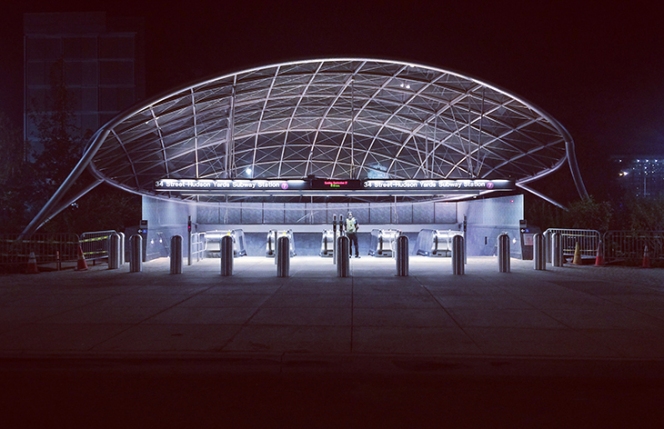 Photo credits Jazzy Li.
Photo credits Jazzy Li.
The superstructure consists of a large double curved stainless steel tube anchored to the ground at three locations. Within the superstructure is a network of grid beams supporting glass panels. 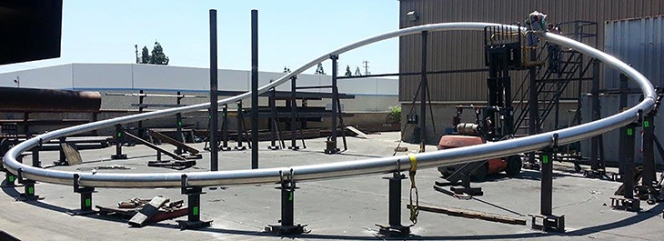 Image credit Trussworks International.
Image credit Trussworks International.
The entire canopy was modeled in Digital Project which allowed us to build in live parameters to control member sizing and system offsets. We also used Rhinoand Grasshopper to document the glass as every panel profile was unique. 
Charles Jones: HCC is a very special project for me. The project Architect, Architect of Record Bayne Dickinson Architect, APAC, was the first person I worked for professionally after graduating from Louisiana State University in 2006. After settling back in New Orleans in 2011 Bayne hired us to assist in the design of this large private residence. The project is located in a heavily forested area on the edge of a bayou, far removed from the city. We wanted to build on this idea and create an entry sequence that conceals the site first and reveals the Architecture on the approach. Once you enter the house the experience is inverted – the Architecture becomes concealed and the site revealed. The project consists of two walls that are organized perpendicular to one another and form the entertainment wing on the ground floor and the private wing on the second floor. These two walls form the boundaries of the motor court which is the first public space that you arrive at, as the entry road bends and emerges from the trees to this dramatic clearing punctuated by a floating wall that conceals the private wing – the levitated mass. 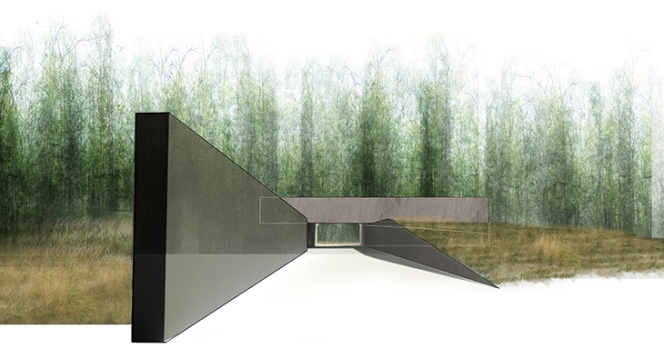
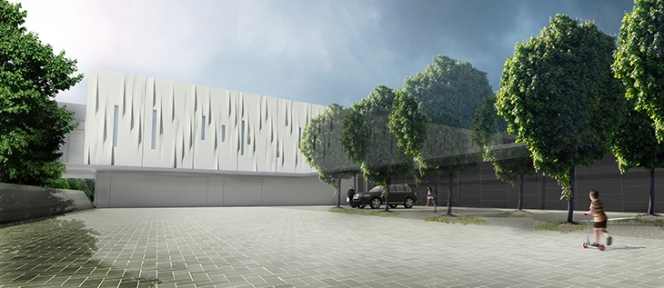
Spanning 120 feet this wall dramatically displays light and shadow as the sun moves across the white, undulating precast panels. 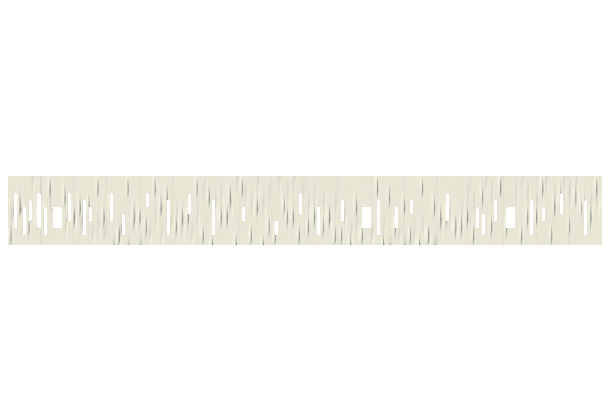
Each panel is unique, however, with Rhinoand Grasshopper we were able to create a series of primitives that could be inserted into the precast molds in any number of ways to help keep fabrication costs down. We worked with Gate Precast to streamline the creation of the primitives and the fabrication process. 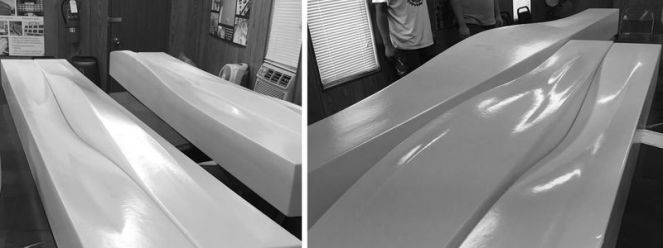 Photo credits Gate Precast.
Photo credits Gate Precast.
Charles Jones: Pelican State Credit Union is an 80,000 sq ft headquarters located in Baton Rouge, Louisiana. The architect of record, Labarre Associates Inc., hired Bayne Dickinson Architect , APAC, and One to One as design consultants to provide the overall direction for schematic design. Pelican State has a great reputation and has been ranked, consecutively, as one of the best places to work in Baton Rouge. The client was very engaged and charged us with the responsibility of creating an environment that fosters activity, creativity, and collaboration. Strategically we decided the building form and footprint should be as efficient as possible to allow room in the budget for a fully integrated landscape design throughout the entire site. The resulting form is a 3 story structure that takes up less than 10% of the site and is oriented east/west along the south side of the site. Positioned in this manner the north side of the site becomes a functional extension of the building in the form of an outdoor plaza that can operate at a variety of scales while also serving as the point of departure to a network of over 5,000 linear feet of walking trails throughout the site. The plaza’s boundaries are further defined by an earth berm to the northwest and waterway to the south that carve and create large canyons on the north side of the building. As a result the building enclosure is most transparent adjacent to the plaza and transitions to a field of horizontal punched openings that wrap the majority of the exterior. 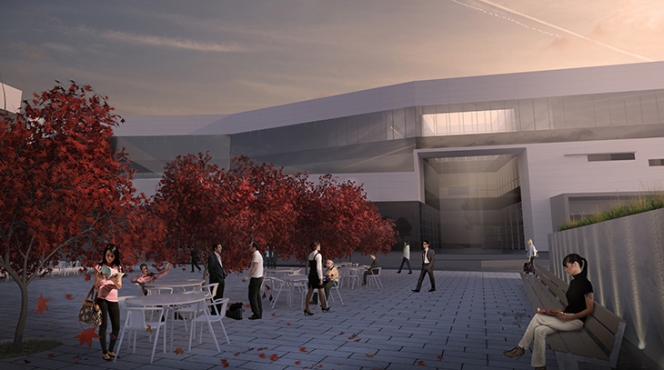
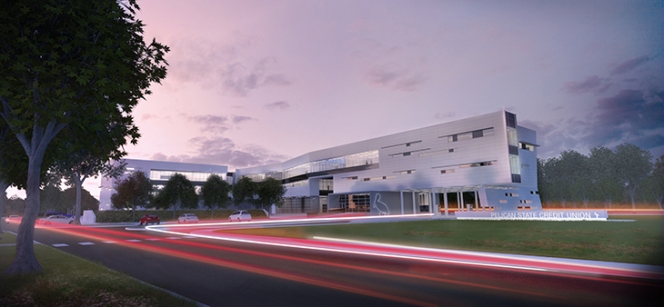 Our most valuable tool throughout this process was a series of simple, transformative diagrams that we used to track and describe the entire design process. Every major move could be clearly traced back to a programmatic, site, or climactic decision. I think it’s critical to make the design process as transparent as possible so the client can easily understand the rationale behind our actions. At the end of the day, this transparency yields a much more fulfilling collaborative process.
Our most valuable tool throughout this process was a series of simple, transformative diagrams that we used to track and describe the entire design process. Every major move could be clearly traced back to a programmatic, site, or climactic decision. I think it’s critical to make the design process as transparent as possible so the client can easily understand the rationale behind our actions. At the end of the day, this transparency yields a much more fulfilling collaborative process. 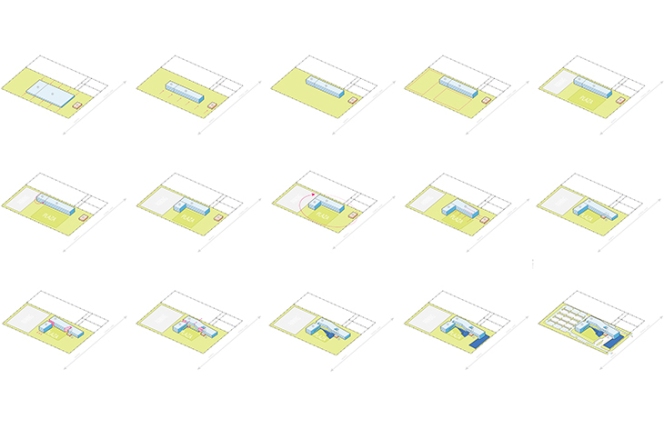
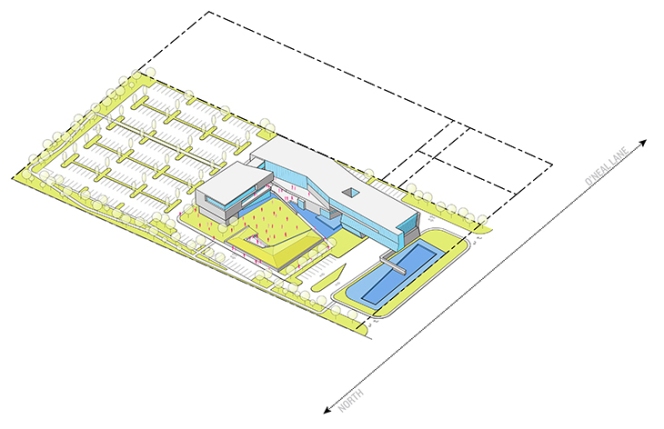
Novedge: How important is keeping up with research?
David Merlin: Research fosters curiosity and creativity. A huge outlet for us is academics. Collectively we teach advanced digital media, digital fabrication, professional concerns, and the occasional design studio. Most of our work in academics is found in our design process and slowly making its way into the final physical result of our work. We believe it’s essential to work with people who have interests beyond the normative practice of Architecture. For instance, each member of our team has a particular interest in the field and beyond that helps keep us fresh.
Novedge: What software do you use?
David Merlin: For software, we always ask: what’s the right tool for the task and you inevitably end up using multiple platforms on projects? Which means, you need to understand the capability of different platforms and the project deliverability. Workflow in the platform and between different platforms needs to be efficient, repeatable, and teachable. The type of work usually dictates the combination of platforms. For full service Architectural projects we’ll use Rhino/Grasshopper to develop initial concepts. A Revit/Dynamo model is developed in parallel for data mining and documentation. Renderings are produced with V-Ray for Rhino and a lot of Photoshop. For consulting projects that involve complex geometry rationalization and detailing, we use Rhino/Grasshopper and or Digital Projectto model, analyze, problem solve, and detail. Documentation for these project is typically done in AutoCAD, but we are exploring alternative workflows to increase efficiency. Our current CAM package is RhinoCAM and for project management we use Mavenlinkand Bluebeam.
Novedge: How did you discover Novedge?
David Merlin: I was searching for Rhinoand V-Raypricing. Novedge’s prices are very competitive, but what sold me were the additional resources like webinars and news feeds. It shows a commitment to your products.
Novedge: You all have held positions in big Architecture Firms and worked with Starchitects in the past: what do you miss about those days and what you don't miss?
Charles Jones: Working at Gehry Partners in Los Angeles was very enlightening. I found myself in the midst of some of the most brilliant minds in Architecture and savored every minute of it. Finding rhythm in the design process was difficult for any newcomer. The complexity in scale, program, and form made it very difficult to penetrate the projects quickly on a conceptual level. The intensity was unreal. Everyone was fully committed to pursuing a common goal, albeit the goal was sometimes a bit elusive. I was fortunate to have a slightly more passive role from a design perspective as the design is primarily driven through physical models. I was in charge of translating the physical model into a digital model. This was the first step in geometry rationalization which ultimately served as the base for drawing production and information used for consultant coordination.
On the other hand, one of the most painful parts of my time there was when the project was shelved. I was hired in a flood new employees, right before the 2008's recession. During the years I worked there I worked on 4 projects, each for approximately 6 months. I spent a year between buildings for the Atlantic Yards Development project, a twisted office tower and the Barclays Arena. I’ll never forget the day we all put pencils down on the Arena. It was a very emotional day for a lot of us. A few of the guys on the design team actually built a coffin that the entire team signed and sent off to rest in peace in the warehouse. However, I was fortunate enough to be transferred to the Foundation Louis Vuitton project where I spent 6 months helping to sculpt the exterior forms of the galleries – or icebergs as we called them. This project has been open for a little over a year now and I can’t wait to visit!
Novedge: You have the choice to design an Airport or a Stadium….what do you chose and why?
Charles Jones: At this point in our careers we lean more toward the spectacle of the stadium than that of the airport. Stadiums are more event driven and the nature of the event is intended to be a collective, shared experience. Stadiums provide their own narrative, one can enjoy the atmosphere, qualities of space, light, sound, smell. I would say that a stadium allows for full immersion of the senses. While the airport is indeed an important asset for globalization and transportation it's almost always difficult to enjoy the space given the transitional nature. Let’s face it though, we are both avid fans of college and professional football and previously worked on Arenas and would welcome the opportunity to participate in the design of another one!
To find out more about ONE to ONE check out their website and follow them on Facebook and Instagram.
To get all the Design Tools for your projects come visit Novedge. And for more resources like our Novedge Webinars Series , keep an eye on our Twitter, Facebookor Google Plusfeed.
Related articles
Also in NOVEDGE Blog

Enhance Your Designs with VisualARQ 3: Effortless Geometry Extensions for Walls and Columns
April 30, 2025 8 min read
Read More
MecSoft Unveils RhinoCAM 2025 and VisualCAD/CAM 2025 with Enhanced Features
March 08, 2025 5 min read
Read MoreSubscribe
Sign up to get the latest on sales, new releases and more …





